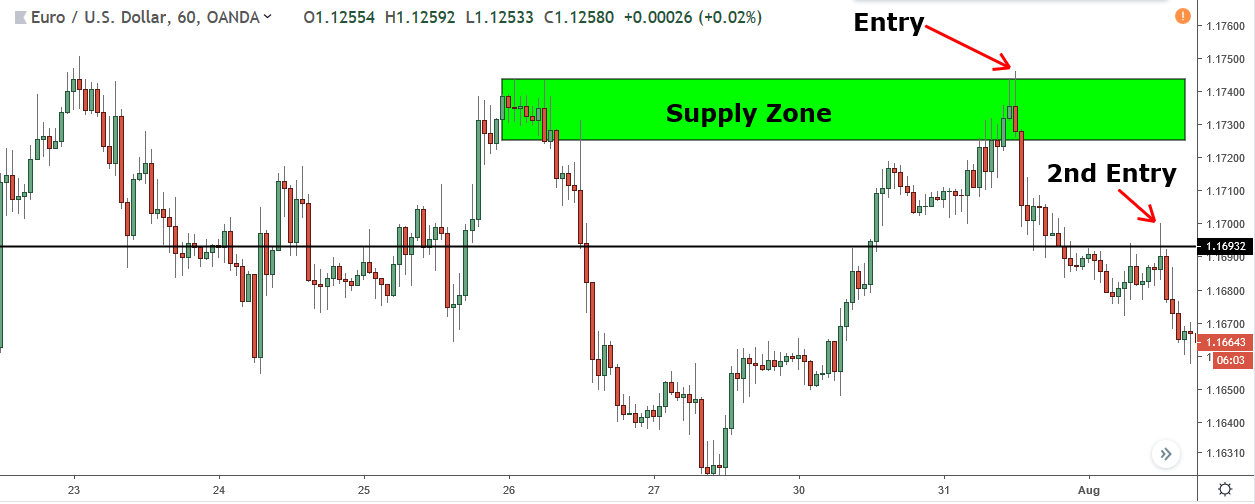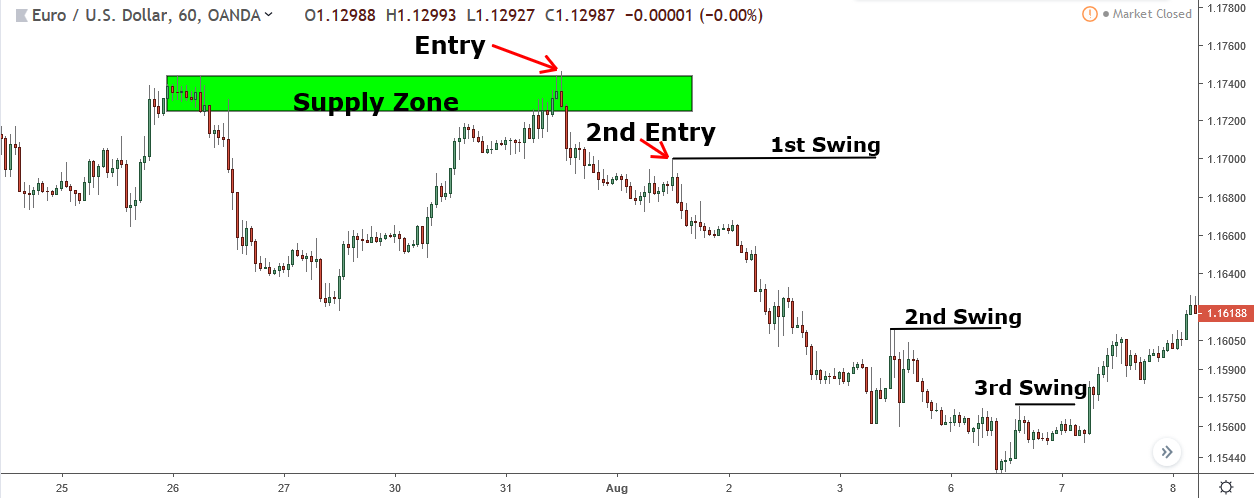It’s the dream isn’t it…
Turn $500 into a million, retire somewhere nice, then spend the rest of your life soaking up the sun.
Can it be done?
Sure, but you won’t get their following the traditional advice…
You need to do things differently.
Today, I’m going to show you 3 methods you can use to double your trading account.
These methods will allow you to double, triple, and in some cases, even quadruple your profit, in a short amount of time, in a controlled non-risky way.
Let’s get to it…
Method #1 Scaling In
What do you normally do after managing to get into a successful trade?
Wait and let the price take its course?
Forget about the trade and move on?
What about place more trades, ever thought of doing that?
It sounds simple, common sense even, but you’d be surprised at the number of traders who, after managing to get themselves into a successful trade (which is hard to do, let’s be honest) simply leave it alone and let the price take it’s course.
The easiest way to increase your profit, once you manage to get in a successful trade, is to PLACE MORE TRADES.
This is called scaling in:
You get into a successful trade and as the price moves in your favour, place more trades to increase the overall profit.
Scaling in is one of the quickest ways to turn a small account into a big one, but it is not as easy as just buying more once in a profitable trade.
You need to buy more only when it’s safe to do so and manage your risk in a controlled way.
Sound confusing?
Here’s how it works…
Step 1: Get Into A Trade
So the first thing to do is get yourself into a successful trade – easier said than done, I know.

For this example, I’m going pretend to be in a successful trade taken from a supply zone. But you can use whatever strategy or techniques you want.
So long as manage to somehow get into a profitable trade, that’s all that matters.
Step 2: Move The Stop Above Entry Price.
Now here’s the most important step:
After you get into a profitable trade, you MUST wait for a new swing low to form above the price you entered the trade at and then move your stop loss up to that swing low.
This is done so that we don’t take on any more risk when we place another trade.
If I just placed another trade without moving the stop of the first trade, I’d increase the maximum amount I could potentially lose, because both trades need to have stop-loss set.
By the moving the stop on the first trade above its entry price, however, I reduce the risk of that trade to 0 because if price falls it’ll close the trade above the price I bought at. which means when I place the next trade, I’m not taking on any additional risk.
So remember…
DO NOT place additional trades until the stop on the previous trade has been moved above the entry price of the previous trade.
Step 3: Place Another Trade
With the stop moved up to the new swing low (this could take a while to appear) the next step is to…
Place another trade.
You can use any strategy or technique to place more trades.

In this example, a bullish hammer candlestick forms not long after the stop has been moved. So I’m going to use that as my signal to scale in and get another trade placed.
By the way, remember…
Always enter each new trade the same way you would normally.
Don’t enter using another method or place the stop-loss in a different location, trade it in exactly the same way.
Step 4: Place More Trades
There’s no limit to how many trades you can place using this scaling-in-method.
So long as you make sure the stop on the previous trade is above the entry price each time you place a new trade, you can enter as many as you like.
Note: Make sure each new trade is placed at the same amount as the first trade otherwise you could into trouble and lose a lot of money.
Step 5: Take Profits By Moving The Stop
Like most strategies, the best way to take profits using the scaling in method is by moving the stop of each trade whenever a new swing low (or high, if you’re trading a downmove) forms.
 Moving the stop to each new low (or high, in our case) allows you to secure profit whilst at the same time lets you keep your trades open if the price continues to move in the direction you expected.
Moving the stop to each new low (or high, in our case) allows you to secure profit whilst at the same time lets you keep your trades open if the price continues to move in the direction you expected.
Now, in our example, there weren’t that many opportunities to enter additional trades after the first had been placed. However, that won’t always be the case…
Imagine how many opportunities to scale in there are during a movement like this…

Method #2 Double Up
Of the three methods listed here, this is the riskiest and is one you should probably avoid if you have a short fuse or can’t handle losing money.
The “Double Up” method is all about doubling up.
It’s based around a famous gambling strategy called “The Martingale”, where, after each loss, you double the size of your stake so that the next time you win you make back the losses as well as a profit on top.
If it sounds kind of risky, that’s because it is.
In fact, gambling sites promote the “Martingale” because they know in the long run it doesn’t work.
Even though it doesn’t work, the doubling up strategy differs from the “Martingale” in that isn’t about doubling up after a loss…
It’s about doubling up after a win.
Think about this for a minute…
Would you rather:
A. Spend all your time trading at the same amount and always make (and lose) a similar amount of money.
B. Trade at the same amount but occasionally take a big risk (but one that’s controlled) to potentially make a much bigger amount.
…it’s got to be, B right?
Well, this is exactly what the double up strategy allows you to do:
Use a small bit of money to (potentially) make a bigger bit to grow your account massively.
How Does The Double Up Method Work?
Now you know a little bit about what the “Double Up” method is and where it came from, let me show you how it actually works.
So the method itself is really simple:
You make a decent profit on a trade and then use some of that profit to buy significantly more on the next trade.
And that’s it!
That’s how it works:
You have a trade, make a profit on it and then use some of the profit to buy more on the next trade.
If it’s successful, you make a TON of money and the size of your account increases dramatically.
If it fails, you just lose a bit of profit.
Simple.
The question everyone probably has now is “How much of my profit should I use on the trade?”.
In my opinion, you should split it 40:60 or 50:50.
By doing that you keep around half of the profit made on the trade, which is still a decent amount if the second trade – the one taken at a much higher amount – doesn’t wind up being successful.
You can, of course, use as much profit as you want, but I think it’s better to be safe and conservative rather than go all out, at least that way you still have some left if you do lose.
Method #3 Trade More Setups/Strategies
The easiest way to speed up the time it takes to turn a small account into a big one is to start trading more setups and strategies.
People often say you should only trade one strategy.
…I agree.
However, I think it’s a good idea to use other setups and strategies too, to increase the amount of money you make and balance out the bottom line.
When you trade one strategy it’s easy to have losing streaks because you’re always taking the same signals.
But when you trade multiple strategies and setups – like trading supply and demand as well as hammer candlesticks – it’s much harder to go on a losing streak, because the hammer candlestick is a completely different signal, so it doesn’t interfere with the probabilities of the supply and demand trades.
“Which strategies/setups should I use?”
With the enormous selection of different trading strategies and setups out there, choosing which to use together isn’t that easy.
I think it’s best to have one “core” strategy and then several setups you look for on-top of that.
For example, my ‘core’ strategy is supply and demand/price action.
That’s my bread and butter and that’s what gives me most of my trades.
But in addition to that I also watch for hammer candlesticks, both on their own and at levels of support and resistance (I also watch for them at fibonacci retracements – more on this in a future post).
Hammers don’t form at S & R levels that often, but when they do they typically give powerful signals, which allows me to make more money while at the same time lessen the impact of losing streaks created from trading supply and demand zones.
Ultimately, there’s no right or wrong combination of strategies/setups to use.
The only thing to remember is to not go overboard with strategies/setups that appear very often, because the more signals you get the more money you can make but at the same time the more you can lose.
So don’t go crazy and trade 3 or 4 different strategies and setups.
Pick one ‘core’ strategy that gives you a nice amount of signals and then have two or three setups (like the hammer candlestick) that provide you with fewer signals but have a high probability of being successful.
Summary
It might not be easy, and it may take a lot longer than you anticipated, but turning a small account into a big one is 100% possible, and will be a lot easier with the 3 methods I’ve given you today.
